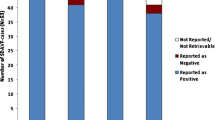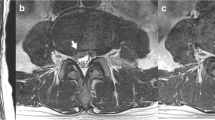Abstract
The role of multi-detector-row computed tomographic angiography (MDCTA) in spinal vascular malformations has not yet been determined. We present a report on a short series of spinal arteriovenous fistulae (AVF) evaluated by MDCTA. With 4-row and 16-row MDCTA, three cases of spinal dural AVF and one case of perimedullary AVF were examined. Each case was also examined by magnetic resonance (MR) imaging and spinal catheter angiography. In two patients with spinal dural AVF, including one patient with angiographically occult AVF, MDCTA successfully located the site of the AVF in a multi-planar reformation image. MDCTA failed to locate the remaining case of spinal dural AVF, probably due to the small amount of shunting blood volume at the fistula. In a patient with perimedullary AVF, MDCTA visualized the broad range of the lesion, including the anterior spinal artery as a single feeder, the fistulous point, and the single perimedullary draining vein. In conclusion, although conventional spinal angiography might be still essential, MDCTA provides useful information for the surgeon in treatment of the spinal dural AVF. Further accumulation of clinical cases is required to determine the potential of MDCTA for perimedullary AVF. MDCTA should be considered as a choice of investigation in the evaluation of spinal AVFs.



Similar content being viewed by others
References
Aminoff MJ, Logue V (1974) The prognosis of patients with spinal vascular malformations. Brain 97:211–218
Anson JA, Spetzler RF (1992) Classification of spinal arteriovenous malformations and implications for treatment. Barrow Neurol Inst Q 8:2–8
Bertrand D, Douvrin F, Gerardin1 E, Clavier E, Proust F, Thiebot J (2004) Diagnosis of spinal dural arteriovenous fistula with multidetector row computed tomography: a case report. Neuroradiology 46:851–854
Boll DT, Bulow H, Blackham KA, Aschoff AJ, Schmitz BL (2006) MDCT angiography of the spinal vasculature and the artery of Adamkiewicz. AJR Am J Roentgenol 187:1054–1060
Doppman JL, Oldfield EH (1995) Surgical interruption of intradural draining vein as curative treatment of spinal dural arteriovenous fistulas. J Neurosurg 82:196–200
Eskandar EN, Borges LF, Budzik RF Jr., Putman CM, Ogilvy CS (2002) Spinal dural arteriovenous fistulas: experience with endovascular and surgical therapy. J Neurosurg 96:162–167
Farb RI, Kim JK, Willinsky RA, Montanera WJ, terBrugge K, Derbyshire JA, van Dijk JM, Wright GA (2002) Spinal dural arteriovenous fistula localization with a technique of first-pass gadolinium-enhanced MR angiography: initial experience. Radiology 222:843–850
Hida K, Iwasaki Y, Goto K, Miyasaka K, Abe H (1999) Results of the surgical treatment of perimedullary arteriovenous fistulas with special reference to embolization. J Neurosurg 90:198–205
Kalra MK, Maher MM, D’Souza R, Saini S (2004) Multidetector computed tomography technology: current status and emerging developments. J Comput Assist Tomogr 28:S2–S6
Krings T, Mull M, Gilsbach JM, Thron A (2005) Spinal vascular malformations. Eur Radiol 15:267–278
Lai PH, Pan HB, Yang CF, Yeh LR, Hsu SS, Lee KW, Weng MJ, Wu MT, Liang HL, Chen CK (2005) Multi-detector row computed tomography angiography in diagnosing spinal dural arteriovenous fistula: initial experience. Stroke 36:1562–1564
Lai PH, Weng MJ, Lee KW, Pan HB (2006) Multidetector CT angiography in diagnosing type I and type IVA spinal vascular malformations. AJNR Am J Neuroradiol 27:813–817
Lee JH, Kim SJ, Cha J, Kim HJ, Lee DH, Choi CG, Lee HK, Suh DC, Ahn JS (2005) Postoperative multidetector computed tomography angiography after aneurysm clipping: comparison with digital subtraction angiography. J Comput Assist Tomogr 29:20–25
Luetmer PH, Lane JI, Gilbertson JR, Bernstein MA, Huston J 3rd, Atkinson JL (2005) Preangiographic evaluation of spinal dural arteriovenous fistulas with elliptic centric contrast-enhanced MR angiography and effect on radiation dose and volume of iodinated contrast material. AJNR Am J Neuroradiol 26:711–718
McCutcheon IE, Doppman JL, Oldfield EH (1996) Microvascular anatomy of dural arteriovenous abnormalities of the spine: a microangiographic study. J Neurosurg 84:215–220
Niimi Y (2004) Diagnosis and treatment of spinal dural arteriovenous fistulae (in Japanese). No To Shinkei 56:863–872
Oldfield EH, Bennett A 3rd, Chen MY, Doppman JL (2002) Successful management of spinal dural arteriovenous fistulas undetected by arteriography. Report of three cases. J Neurosurg 96:220–229
Romano M, Mainenti PP, Imbriaco M, Amato B, Markabaoui K, Tamburrini O, Salvatore M (2004) Multidetector row CT angiography of the abdominal aorta and lower extremities in patients with peripheral arterial occlusive disease: diagnostic accuracy and interobserver agreement. Eur J Radiol 50:303–308
Saraf-Lavi E, Bowen BC, Quencer RM, Sklar EM, Holz A, Falcone S, Latchaw RE, Duncan R, Wakhloo A (2002) Detection of spinal dural arteriovenous fistulae with MR imaging and contrast-enhanced MR angiography: sensitivity, specificity, and prediction of vertebral level. AJNR Am J Neuroradiol 23:858–867
Schoenhagen P, Stillman AE, Halliburton SS, Kuzmiak SA, Painter T, White RD (2005) Non-invasive coronary angiography with multi-detector computed tomography: comparison to conventional X-ray angiography. Int J Cardiovasc Imaging 21:63–72
Steinmetz MP, Chow MM, Krishnaney AA, Andrews-Hinders D, Benzel EC, Masaryk TJ, Mayberg MR, Rasmussen PA (2004) Outcome after the treatment of spinal dural arteriovenous fistulae: a contemporary single-institution series and meta-analysis. Neurosurgery 55:77–87
Takase K, Akasaka J, Sawamura Y, Ota H, Sato A, Yamada T, Higano S, Igarashi K, Chiba Y, Takahashi S (2006) Preoperative MDCT evaluation of the artery of Adamkiewicz and its origin. J Comput Assist Tomogr 30:716–722
Yoon DY, Choi CS, Kim KH, Cho BM (2006) Multidetector-row CT angiography of cerebral vasospasm after aneurysmal subarachnoid hemorrhage: comparison of volume-rendered images and digital subtraction angiography. AJNR Am J Neuroradiol 27:370–377
Zampakis P, Santosh C, Taylor W, Teasdale E (2006) The role of non-invasive computed tomography in patients with suspected dural fistulas with spinal drainage. Neurosurgery 58:686–694
Author information
Authors and Affiliations
Corresponding author
Additional information
Comments
Ludwig Benes, Marburg, Germany
Yamaguchi and co-workers have interestingly detailed their first experience of multi-detector-row CT angiography (MDCTA) for the preoperative examination of patients suffering from spinal arteriovenous fistulae. Since the demonstration of the artery of Adamkiewicz by multi-detector-row helical CT by Takase et al. in 2002 [1], it is a logically consistent idea to identify dural AV fistulae with this modern technique. Although the patient number is limited (n = 4), the authors add a valuable diagnostic tool for dural and perimedullary AV fistulae apart from spinal DSA and MRI angiography. Spinal dural and perimedullary AV fistulae are rare diseases, and the prospective evaluation of MDCTA in comparison with the diagnostic standards will be a very challenging task for the future. Until then, conventional spinal DSA should be kept as the gold standard diagnostic feature for these vascular abnormalities.
Reference
1. Takase K, Sawamura Y, Igarashi K, Chiba Y, Haga K, Saito H, Takahashi S (2002) Demonstration of the artery of Adamkiewicz at multi-detector row helical CT. Radiology 223(1):39–45
Timo Krings, Aachen, Germany
Spinal vascular malformations are rare and still under-diagnosed entities which, if not treated properly, can lead to considerable morbidity, with progressive spinal cord symptoms. Depending on the type of vascular malformation, initial symptoms may vary between acute onset of neurological deficits due to intramedullary or subarachnoidal haemorrhages and subacute onset due to venous congestion leading to progressive myelopathy. While the latter pathomechanism leads to non-specific initial neurological symptoms that can make an early diagnosis difficult, the former leads to acute manifestations of spinal vascular malformations that are typically diagnosed early in the course of the disease. For the diagnosis, classification and subsequent treatment of these rare entities, spinal super-selective digital subtraction angiography is necessary. Since this technique is technically demanding, especially in elderly patients, non-invasive methods to diagnose the pathological shunt and to locate the height of the feeding arteries are of great interest. These techniques require a high spatial and temporal resolution and a large field of view, since arteries of the spine and spinal cord are small in calibre, difficult to distinguish from their venous counterparts and variable in location. The very interesting article by Yamaguchi et al. describes four patients in whom CT angiography was performed to locate the fistula. This technique is promising, and further research, especially in a larger group of patients, has to be done; however, some potential shortcomings have to be stressed as well: the field of view necessary to scan for spinal dural AV fistulae is large (in fact these pathological shunts may be encountered from the foramen magnum to the sacral region), therefore, the amount of radiation is considerable, the bolus timing difficult and potential breathing artefacts may degrade image quality. Likewise, an early (i.e. arterial) demonstration of venous structures may be difficult to achieve with a prolonged intravenous bolus. Since arteriovenous transit time is approximately 10 s in the spine, a clear separation between the arterial phase and the venous phase may be difficult to achieve, resulting in non-visualization of the great radiculomedullary artery. Whether or not this artery is arising from the same segmental artery as the shunting artery is an important piece of information, which is why we always perform super-selective spinal angiography prior to a therapeutic intervention. Still, many of these described shortcomings will be solved with further evolution of scanner hardware and software. In this regard, the present article can be seen as a “proof of principle” of a new and emerging technology that will be of help for the physician treating patients with spinal vascular malformations.
Rights and permissions
About this article
Cite this article
Yamaguchi, S., Eguchi, K., Kiura, Y. et al. Multi-detector-row CT angiography as a preoperative evaluation for spinal arteriovenous fistulae. Neurosurg Rev 30, 321–327 (2007). https://doi.org/10.1007/s10143-007-0088-2
Received:
Revised:
Accepted:
Published:
Issue Date:
DOI: https://doi.org/10.1007/s10143-007-0088-2




